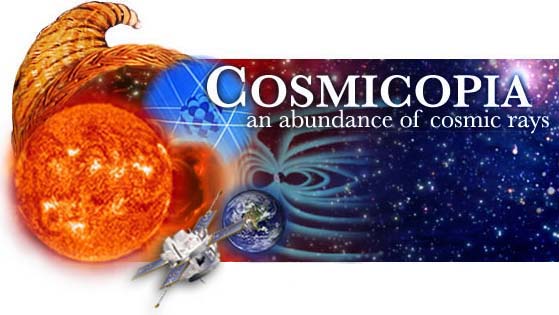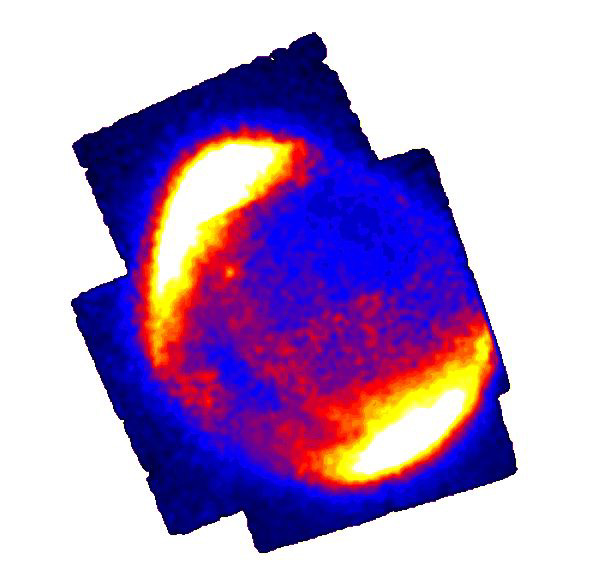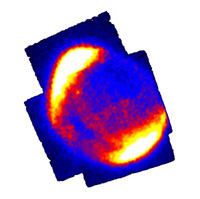
Acceleration

When particles are accelerated by a shock, as in solar events, they are knocked back and forth across the shock by the energy waves it generates. The particles gain energy and scatter more on each trip across the shock. The number of particles and strength of the waves decrease as they travel further away from the shock, to a point where there are not enough particles to produce strong waves. The particles then flow away from the shock.
This false color composite picture of the bright supernova remnant SN1006 (so named because it was first seen in the year 1006) was taken by the ASCA satellite. The expanding gas from the star collided into the surrounding material. The collision generated a violent shock, which produced x-ray light. The bright regions in the picture show the locations of this shock along the rim of the remnant. The energy spectrum produced in SN1006 provides the first clear link between particle acceleration at supernova shock fronts and high-energy cosmic rays. Image courtesy of Drs. R. Petre and E. Gotthelf, NASA GSFC.
 Acceleration in the News
Acceleration in the News
January 5, 2009: Desktop atom smashers could replace LHC -- New Scientist
January 2, 2009: European first as ALICE achieves energy recovery at 11 million volts -- Science Daily
December 31, 2008: Top ten physics stories of the year -- includes the Large Hadron Collider, quarks, and GCRs -- American Institute of Physics (AIP)
December 27, 2008: Crab pulsar wind nebula -- APOD
December 12, 2008: Michigan State will host rare isotope facility -- Physics World
December 3, 2008: Speaker sees new collider as a cooperative effort to solve nature's mysteries -- AAAS
October 13, 2008: Brookhaven Lab's Satoshi Ozaki awarded the Rober R. Wilson Prize -- Brookhaven National Laboratory
October 10, 2008: The day the world didn't end -- Science@NASA
September 25, 2008: Powerful nearby supernova caught by web -- NASA
September 15, 2008: SN 1006: A supernova ribbon from Hubble -- APOD
August 29, 2008: Integral locates origin of high-energy emission from Crab Nebula -- ESA
July 11, 2008: The Far 3kpc Arm -- APOD
June 13, 2008: At last, GLAST -- APOD
May 9, 2008: Colliding with nature's best-kept secrets -- CNN
April 3, 2008: South of Orion -- APOD
March 6, 2008: Vela Supernova Remnant -- APOD
February 25, 2008: Transformer -- HEAPOW
February 20, 2008: Integral: Stellar winds colliding at our cosmic doorstep -- ESA
February 8, 2008: NASA calls for suggestions to rename future telescope mission -- NASA GSFC
January 30, 2008: Galaxy distortions shed light on cosmic acceleration -- Physics World
Januray 27, 2008: Giant particle accelerator discovered in the sky -- Science Daily
January 10, 2008: Active galaxy Centaurus A -- APOD
November 28, 2007: UNH scientists report first findings on key astrophysics problem -- Eurekalert
September 2, 2003: Antimatter factory on Sun yields clues to solar explosions -- NASA GSFC
September 2, 2003: RHESSI satellite offers clues about how solar explosions act as particle accelerators -- UC Berkeley News
November 18, 2002: First 3-D magnetic reconnection measurements -- SpaceDaily
November 12, 2002: Satellite finds electrons brought to near-light speed -- Spaceflight Now
November 7, 2002: UC Berkeley analysis of satellite data turns up first direct evidence that magnetic processes in space can accelerate electrons to near light speed -- UC Berkeley






Questions and comments to: cosmicopia@cosmicra.gsfc.nasa.gov
Curator: Beth Barbier, SP Systems
Responsible NASA Official: Dr. Tycho von Rosenvinge
Privacy Policy and Important Notices

HOME
In the News
History
Ask Us
Great Links
Glossary
Site Map
Search NASA